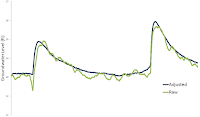There are entire blogs dedicated to uncovering the conspiracy to alter the globe's temperature. The premise is as follows—through supposed “adjustments,” nefarious scientists manipulate raw temperature measurements to create (or at least inflate) the warming trend. People who subscribe to such theories argue that the raw data is the true measurement; they treat the term “adjusted” like a synonym for “fudged.”
Peter Thorne, a scientist at Maynooth University in Ireland who has worked with all sorts of global temperature datasets over his career, disagrees. “Find me a scientist who’s involved in making measurements who says the original measurements are perfect, as are. It doesn’t exist,” he told Ars. “It’s beyond a doubt that we have to—have to—do some analysis. We can’t just take the data as a given.”
Speaking of data, the latest datasets are in, and 2015 is (as expected) officially the hottest year on record. It's the first year to hit 1°C above levels of the late 1800s. And to upend the inevitable backlash that news will receive (*spoiler alert*), using all the raw data without performing any analysis would actually produce the appearance of more warming since the start of records in the late 1800s.
Beating 2014, it was the first year to hit 1°C above levels of the late 1800s.
We're just taking the temperature—how hard can it be?
So how do scientists build datasets that track the temperature of the entire globe? That story is defined by problems. On land, our data comes from weather stations, and there’s a reason they are called weather stations rather than climate stations. They were built, operated, and maintained only to monitor daily weather, not to track gradual trends over decades. Lots of changes that can muck up the long-term record, like moving the weather station or swapping out its instruments, were made without hesitation in the past. Such actions simply didn’t matter for weather measurements.
The impacts of those changes are mixed in with the climate signal you’re after. And knowing that, it’s hard to argue that you shouldn’t work to remove the non-climatic factors. In fact, removing these sorts of background influences is a common task in science. As an incredibly simple example, chemists subtract the mass of the dish when measuring out material. For a more complicated one, we can look at water levels in groundwater wells. Automatic measurements are frequently collected using a pressure sensor suspended below the water level. Because the sensor feels changes in atmospheric pressure as well as water level, a second device near the top of the well just measures atmospheric pressure so daily weather changes can be subtracted out.
If you don't make these sorts of adjustments, you’d simply be stuck using a record you know is wrong.
Read more at Thorough, Not Thoroughly Fabricated: the Truth About Global Temperature Data

No comments:
Post a Comment